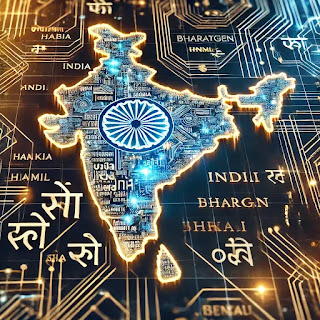In the rapidly evolving world of artificial intelligence, India is making groundbreaking strides with BharatGen, the first government-funded Multimodal Large Language Model (LLM) Initiative. As AI becomes increasingly crucial in shaping global innovation, BharatGen aims to address India's unique linguistic and cultural diversity by building AI models that truly represent the nation’s ethos.

From fostering indigenous AI development to reducing reliance on foreign technologies, BharatGen is set to transform the way AI models understand and interact with India’s vast multilingual landscape. In this article, we delve into the vision behind BharatGen, its unique features, and how it’s poised to elevate India's position in the global AI ecosystem.
The Vision Behind BharatGen
India is a land of unparalleled linguistic diversity, with over 1,600 languages spoken across its states and territories. As AI technologies gain prominence, it is essential that they cater to this diversity to ensure inclusivity and representation. BharatGen was launched with a bold vision to democratize AI access, enabling people from all linguistic backgrounds to interact seamlessly with generative AI systems.
Why Was BharatGen Launched?
Linguistic Diversity: Most existing AI models are heavily skewed towards English and a few global languages, leaving many Indian languages underrepresented.
Reducing Dependence on Foreign AI: With growing geopolitical and technological challenges, relying on foreign AI solutions poses risks to data sovereignty and national security.
Strengthening the Domestic AI Ecosystem: BharatGen is designed to empower startups, industries, and government agencies by providing them with cutting-edge, domestically developed AI technologies.
Core Features of BharatGen
BharatGen is uniquely positioned as a comprehensive initiative with four distinct features that set it apart from other generative AI models:
1. Multilingual and Multimodal Models
BharatGen’s foundation models are multilingual and multimodal, enabling them to process text, speech, images, and more, while being proficient in multiple Indian languages. This makes the system adaptable to various applications, from voice assistants to image recognition in diverse linguistic contexts.
2. Bhartiya Dataset-Based Building and Training
The development of BharatGen is grounded in a Bhartiya dataset, meticulously curated to include text, voice, and visual data from diverse Indian languages. This dataset ensures that the model understands the nuances of regional dialects and cultural contexts, fostering more accurate and relatable AI interactions.
3. Open-Source Platform
BharatGen embraces an open-source approach, fostering innovation and collaboration within the AI community. By allowing developers and researchers to access and enhance the models, it encourages collective progress while maintaining transparency and adaptability.
4. Ecosystem Development
A critical aspect of BharatGen’s mission is to develop a thriving ecosystem of generative AI research. Through strategic partnerships with academia, startups, and research institutions, the initiative aims to create a sustainable pipeline of AI innovations tailored to India’s needs.
Bharat Data Sagar: A Treasure Trove of Indigenous Data
An integral part of BharatGen is the Bharat Data Sagar initiative, which focuses on primary data collection. The goal is to compile vast amounts of data from less-represented Indian languages, ensuring that the AI models built are culturally inclusive and contextually aware.
Addressing the Data Gap
India’s linguistic diversity has historically been a challenge for global AI models, which predominantly train on data from high-resource languages. Bharat Data Sagar directly addresses this gap by gathering data that reflects the richness of regional dialects and linguistic variations.
What Are Large Language Models (LLMs)?
LLMs (Large Language Models) are AI systems trained on extensive datasets to understand and generate human-like text. These models, like GPT (Generative Pre-trained Transformer), can answer questions, summarize texts, write creatively, and even perform programming tasks.
How Do LLMs Work?
LLMs learn from vast amounts of text data to identify patterns, context, and meaning. Through advanced neural networks, they develop an understanding that enables them to generate coherent and contextually accurate responses.
Significance of BharatGen in the Global AI Landscape
With the launch of BharatGen, India positions itself at the forefront of inclusive AI development. Here’s why BharatGen is a game-changer:
1. Empowering Indigenous AI Innovation
By reducing dependence on foreign AI models, BharatGen paves the way for self-reliance and technological sovereignty.
2. Preserving Cultural and Linguistic Diversity
By ensuring that AI systems understand regional languages and dialects, BharatGen helps preserve India’s rich linguistic heritage.
3. Boosting the Startup Ecosystem
An open-source platform means that Indian startups and developers can build on BharatGen’s models, fostering innovation and job creation.
FAQs
1. What is BharatGen?
BharatGen is India's first government-funded Multimodal Large Language Model Initiative, focusing on creating AI models that represent India’s linguistic and cultural diversity.
2. What is the goal of BharatGen?
The primary aim is to reduce dependency on foreign technologies and develop indigenous AI capabilities that are more aligned with Indian languages and contexts.
3. What makes BharatGen different from other AI initiatives?
Its multilingual and multimodal nature, focus on Indian datasets, open-source approach, and emphasis on ecosystem development make it unique.
4. Why is Bharat Data Sagar important?
Bharat Data Sagar ensures the availability of data from underrepresented Indian languages, crucial for training accurate and contextually aware AI models.
5. How does BharatGen benefit the Indian AI ecosystem?
It boosts indigenous innovation, supports startups, and enhances the nation’s data sovereignty by developing AI solutions that are rooted in Indian realities.
Conclusion
BharatGen is more than just an AI initiative; it is a visionary project aimed at making AI inclusive, culturally relevant, and linguistically representative of India’s diversity. As the world moves toward advanced generative models, BharatGen’s focus on self-reliance and diversity could redefine AI development in the country and beyond. The initiative not only enhances technological independence but also strengthens India’s position as a global leader in next-generation AI technologies.






